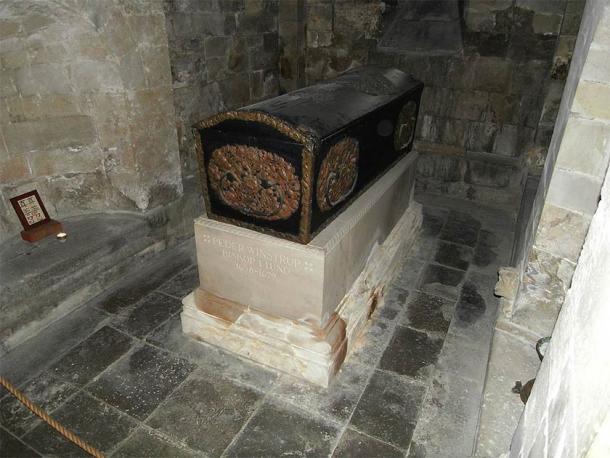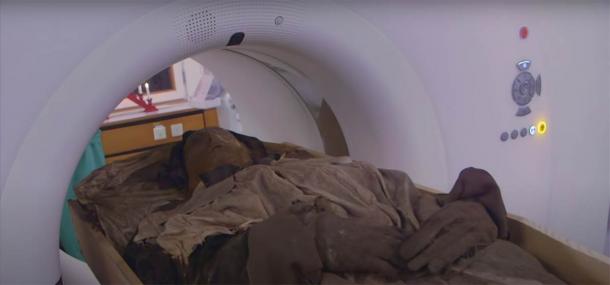The ancient origins of tuberculosis have finally been identified after a team of scientists followed a trail of molecular breadcrumbs through the lung of a Danish mummified bishop. Peder Pedersen Winstrup (1605-1679 AD) was born in Copenhagen, Denmark, and this larger than life man became an accomplished architect, scientist and book-printer. He was then appointed as a prominent Lutheran bishop overlooking Lund in Scania, in what is today Sweden, until he died after a long battle with illness at age 74. It was this Danish mummified bishop that provided new evidence of the origins of tuberculosis.
According to an entry on Mummipedia, in June 2015 Winstrup ’s grave was relocated from the Lund crypt to the northern tower at which time his exceptionally-well preserved mummy was examined with CT and x-ray scanning technologies, revealing an image that made the world’s scientific community stand still. Beneath the bishop’s feet was the body of “a 5-months-old fetus,” and it is though that perhaps the child had been born illegitimately and that the bishop ’s burial might have been chosen so that the child had a respectable Christian burial .

The coffin of Peder Winstrup, bishop in the city of Lund between the years 1638 and 1679, whose body led to a better understanding of the early origins of tuberculosis. (Jin Zan / CC BY-SA 4.0 )
Initial Danish Mummified Bishop Analysis Indicated TB
In 2015 it was discovered that Winstrup ate a high-fat, sugary diet that led to significant tooth decay , type 2 diabetes, arthritis, plaque and gallbladder problems. However, when a large amount of sinus fluid was discovered in his head it was suspected that he had “probably” died from tuberculosis and pneumonia. Further investigations have now proven this to be true.
Anthropologist Caroline Arcini and a team of scientists from the Swedish Museum of Natural History successfully identified “small calcifications” in the lungs of bishop Peder Winstrup’s mummy which they suspected were remnants of a past lung infection, and “tuberculosis” was at the top of their list of suspects.

The bishop’s mummified body entering the CT scanning equipment. (Lund University / YouTube screenshot )
A new study published in Genome Biology by Susanna Sabin of the Max Planck Institute, for the Science of Human History MPI-SHH, and colleagues, presents a “reconstructed tuberculosis genome” that they assembled using a calcified nodule from Winstrup ’s lung. The report confirms that he had been exposed to the Mycobacterium tuberculosis bacteria, which causes tuberculosis (TB), an invisible killer known in medieval Europe as “White Plague.”
Scientific Findings Rewrite the Origin and History of TB
Discovering the bishop ’s lung calcification meant the team were able to acquire infected DNA from an ancient European and this allowed the researchers to revisit the question of when exactly in history tuberculosis emerged, said Kirsten Bos, group leader for Molecular Paleopathology at the (MPI-SHH), who co-led the study. And by reconstructing an ancient TB genome using data from Bishop Winstrup’s lung the team gained a “secure and independent calibration” for their estimate on how old TB actually is.
Questioning the age of the Mycobacterium tuberculosis complex and using the day of the bishop ’s death as a “fine-tuned calibration point,” the team applied a series of molecular dating models revealing the Mycobacterium tuberculosis complex as having a relatively young age of origin. This proved that TB had not emerged when humans left Africa tens of thousands of years ago as mainstream scientific theory had, until now, maintained.
The Hunt Is On For An Ancient Killer
According to the new paper the origins of the tuberculosis causing pathogen is now supported by genetic evidence from multiple geographic regions and time periods. Dr Sabin concluded that the new study is “the strongest evidence available to date for this emergence having been a Neolithic phenomenon,” which the scientists say coincides with a sharp spike in pastoral living and sedentary lifestyles. Co-author of the report, Denise Kühnert, from the center for disease transmission research at MPI-SHH, said “The Neolithic transition seems to have played an important role for the emergence of a number of human pathogens” and for TB stronger evidence could only come from an older genome. Few scientists expect to ever find a sample in a state even nearly as well-preserved as the samples taken from Bishop Winstrup’s lung.
And while the new paper proves that the TB causing bacteria first invaded human communities in the Neolithic, the research is far from over. Like all life on earth, Mycobacterium too must have had a comparatively deadly ancestor, with even older origins. The hunt for that yet unknown killer ancestor will continue but the Danish mummified bishop has provided the clues to follow.
Top image: The Danish mummified bishop, Peder Pedersen Winstrup, whose body has provided the latest evidence for the ancient origins of tuberculosis. Source: Lund University / YouTube screenshot
By Ashley Cowie
Related posts:
Views: 0
 RSS Feed
RSS Feed

















 August 17th, 2020
August 17th, 2020  Awake Goy
Awake Goy 



 Posted in
Posted in  Tags:
Tags: 
















